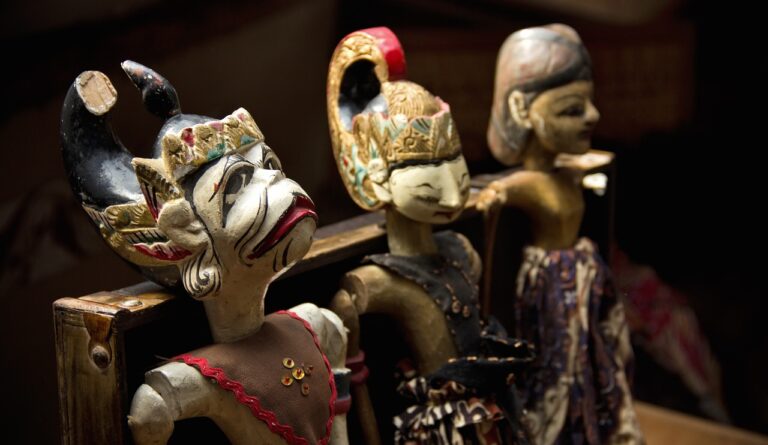Javanese puppet theater, known as “Wayang,” is a traditional form of storytelling that is deeply rooted in the cultural and spiritual life of the Javanese people, who primarily reside on the island of Java in Indonesia. Wayang has been recognized by UNESCO as a Masterpiece of Oral and Intangible Heritage of Humanity. Here’s an overview of what Javanese puppet theater entails:
Types of Wayang
Wayang Kulit
This is the most famous form of Wayang and involves shadow puppetry. The puppets are intricately carved from buffalo hide and mounted on bamboo sticks. Performances are conducted behind a white screen with a light source, creating shadows that the audience views.
Wayang Golek
This form involves three-dimensional wooden rod puppets. It is particularly popular in the Sundanese regions of West Java.
Wayang Wong
This form uses live actors instead of puppets. The actors wear elaborate costumes and masks to portray the characters.
Wayang Klitik
This involves flat wooden puppets and is less common than Wayang Kulit and Wayang Golek.
Themes and Stories
Wayang performances typically draw on a rich tapestry of stories from various sources, including:
– **Hindu Epics**: The Ramayana and Mahabharata are primary sources of stories. Originally from India, these epics have been adapted and localized to fit Javanese culture and values.
– **Local Legends and Folktales**: Stories about Javanese kings, historical events, and local folklore are also popular.
– **Islamic Tales**: Since the spread of Islam in Indonesia, Islamic stories and moral lessons have been incorporated into Wayang performances.
### Cultural and Spiritual Significance
1. **Moral and Ethical Lessons**: Wayang performances often convey moral and ethical lessons, teaching values such as loyalty, bravery, and justice.
2. **Spirituality**: The performances can have a spiritual dimension, reflecting the syncretism of Hindu-Buddhist and Islamic traditions in Javanese culture.
3. **Entertainment and Education**: Besides their spiritual and moral lessons, Wayang performances are a form of entertainment and education, often addressing contemporary social issues in a humorous or satirical manner.
The Dalang
The Dalang, or puppet master, is the central figure in Wayang’s performances.
The Dalang
- He controls the puppets’ movements and brings them to life.
- He provides the characters’ voices and narrates the story.
- He leads the gamelan orchestra, a traditional ensemble of percussive instruments that provides the musical backdrop for the performance.
- He often improvises dialogue and interacts with the audience, making each performance unique.
The Gamelan Orchestra
The gamelan orchestra is an integral part of the Wayang performance. It consists of various traditional instruments, including metallophones, xylophones, drums, gongs, and sometimes string instruments. The music sets the mood, punctuates the action, and enhances the overall experience.
Performance Context
Wayang performances are often held during significant cultural and religious events, such as temple festivals, weddings, and community celebrations. They can last for several hours, sometimes even overnight.
In summary, Javanese puppet theater is a multifaceted art form that combines storytelling, music, and visual artistry. It serves as a medium for cultural expression, spiritual reflection, and social commentary, making it a cornerstone of Javanese heritage.
